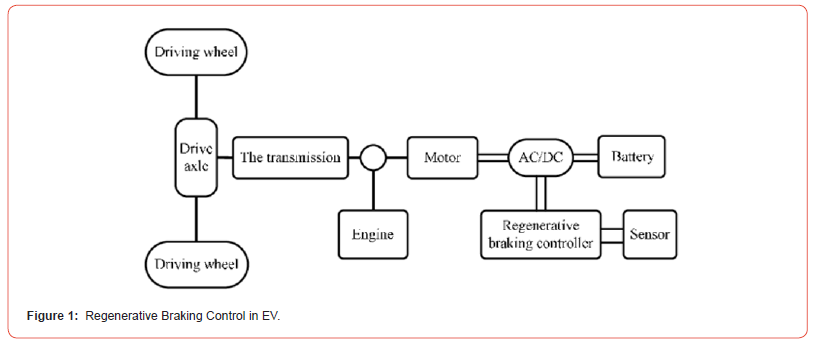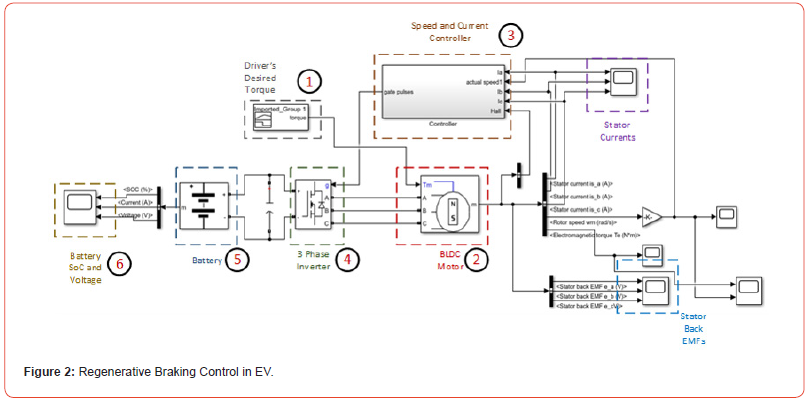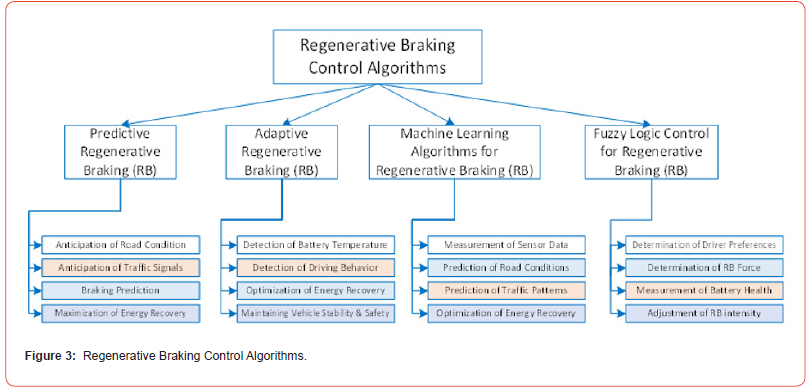 Research Article
Research Article
Innovative Approaches to Boosting Electric Vehicle Energy Efficiency via Regenerative Braking Algorithms
Hina Ayub1, Syed Shehryar Ali Naqvi2*
1Interdisciplinary graduate program in advanced convergence technology and science, Jeju National University, South Korea
2Department of Electronics Engineering, Jeju National University, South Korea
Syed Shehryar Ali Naqvi, Department of Electronics Engineering, Jeju National University, South Korea.
Received Date:January 17, 2024; Published Date:January 23, 2024
Abstract
Regenerative braking has revolutionized traditional hydraulic systems in electric vehicles (EVs), significantly reducing energy waste and enhancing overall efficiency. This method effectively preserves energy and improves braking efficiency by converting kinetic energy into electrical energy during braking. The brake controller continuously monitors wheel speed, calculates the required torque, and captures surplus rotational energy for conversion into electricity during regenerative mode. The advantages of regenerative braking encompass enhanced efficiency, reduced wear, lower fuel usage, and energy conservation. Ongoing advancements, such as integrating flywheels and ultracapacitors with sophisticated converters, continue to refine these systems. This study delves into the mechanics of regenerative braking and explores diverse algorithms to optimize energy efficiency in electric vehicles.
Keywords:Electric Vehicles (EVs); Regenerative Braking (RB)
Introduction
The automobile industry has seen significant changes recently, with a noticeable shift toward electric propulsion technology. This change caused intense research and innovation into a variety of electric vehicle (EV) and hybrid electric vehicle (HEV) dimensions, driven by the desire to reduce greenhouse gas emissions and enhance energy sustainability [1]. Regenerative braking control, a creative technology with the potential to transform the effectiveness and usability of energy conservation in the context of EVs and HEVs, is one of the primary research areas [2].
One key area that shows promise for greatly increasing the total energy economy and range of EVs and HEVs is regenerative braking management. Regenerative braking systems can recover a significant amount of kinetic energy during deceleration, in contrast to conventional friction-based braking systems that release this energy as heat. These systems facilitate the efficient conversion of mechanical energy into electrical energy, which allows energy to be captured and stored. This has two advantages: it reduces waste and increases driving range [3].

Regenerative Braking Control
Integrated Electronic Control Unit
In modern vehicle architecture, integrating Electronic Control Units (ECUs) has revolutionized the control and coordination of various vehicle systems. This integrated ECU environment offers a unique opportunity to manage diverse functions, optimizing overall vehicle performance [4]. Among these functions, the implementation of regenerative braking holds immense significance. The inherent ability of regenerative braking to recover and store energy during deceleration aligns seamlessly with the integrated ECU environment’s goal of holistic energy management [5].
Regenerative Braking Control Structure
In the context of EVs, regenerative braking control involves a well-coordinated system designed to capture and store energy during the braking process. The fundamental block diagram of regenerative braking control (figure 1) consists of several interconnected components that work together seamlessly to optimize energy recapture.
Regenerative Braking Control in EV
In regenerative braking, the torque reference input mimics the effects of a real-world driver applying the brake pedal, which triggers the motor to act as a generator and slow down the vehicle. The generated torque reference signal serves as the command for the PMSM in the simulation. When the torque reference is positive, it instructs the PMSM to produce a driving torque, as in the case of accelerating the vehicle. When the torque reference is negative, it signifies regenerative braking and instructs the PMSM to produce a counter-torque, slowing down the vehicle and recovering energy. The flow of regenerative braking control in EVs is shown in figure 2.

Regenerative Braking Control Strategies
Control algorithms/strategies of regenerative braking control is shown in figure 3.
Predictive regenerative braking control has emerged as a pivotal methodology to enhance electric and hybrid EVs’ energy efficiency and overall performance.
Adaptive regenerative braking control has emerged as a cutting-edge methodology to enhance energy efficiency and adapt to varying driving conditions in electric vehicles (EVs).
Machine learning has revolutionized regenerative braking control in electric vehicles (EVs) and hybrid electric vehicles (HEVs).
Fuzzy Logic Control (FLC) has emerged as a powerful tool in optimizing regenerative braking systems for electric vehicles (EVs).

Acknowledgement
None.
Conflict of Interest
None.
References
- V Omahne, M Knez, M Obrecht (2021) Social aspects of electric vehicles research trends and relations to sustainable development goals. World Electr. Veh. J 12(1): 15.
- B Long, S T Lim, Z F Bai, J H Ryu, K T Chong, et al. (2014) Energy Management and Control of Electric Vehicles, Using Hybrid Power Source in Regenerative Braking Operation. Energies 7(7): 7.
- J Guo, J Wang, B Cao (2009) Regenerative braking strategy for electric vehicles. in 2009 IEEE Intelligent Vehicles Symposium, IEEE pp. 864-868.
- C Qiu, G Wang, M Meng, Y Shen (2018) A novel control strategy of regenerative braking system for electric vehicles under safety critical driving situations. Energy 149: 329-340.
- M Sabri, K A Danapalasingam, M F Rahmat (2016) A review on hybrid electric vehicles architecture and energy management strategies. Renew Sustain Energy Rev 53: 1433-1442.
-
Giuseppe Mavilia, Maria Teresa Caccamo, Letterio Mavilia* and Salvatore Magazù. XRD, FTIR and RAMAN Characterizations of Metakaolin Geopolymers. Mod Concept Material Sci. 5(4): 2024. MCMS. MS.ID.000619.
-
Electric Vehicles (EVs), Regenerative Braking (RB), Greenhouse, Algorithms, Electricity, Energy, Architecture, Efficiency
-

This work is licensed under a Creative Commons Attribution-NonCommercial 4.0 International License.






